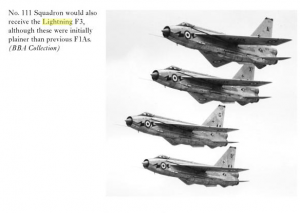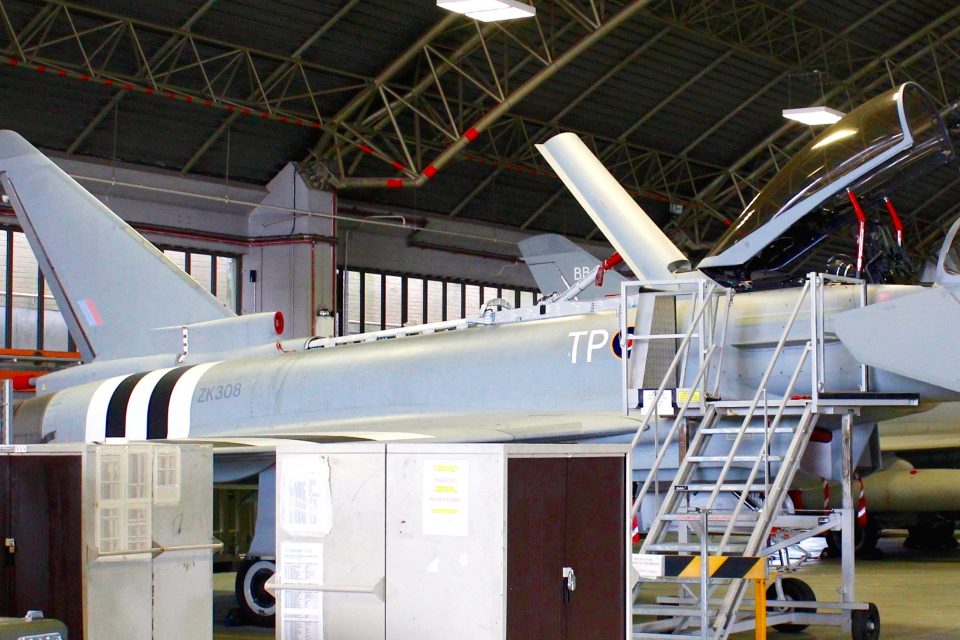2015-09-26
“In June 2005 the Squadron officially moved to its home base at RAF Coningsby and by July it was teaching new pilots for 17(R) Squadron on a formal course.
Bucking the trend of recent squadron disbandments, 29(R) Squadron officially ‘stood up’ for operational service on 4 November 2005.
This signified a major milestone in the introduction of the Typhoon to RAF service, as it indicated that the Squadron was now ready to begin training front-line pilots to fully equip current and future Typhoon squadrons.
For 29(R) Squadron it heralded a long and healthy future, one that seems certain to last until the centenary and beyond.”
http://www.raf.mod.uk/organisation/29squadron.cfm
When visiting 29 Squadron at RAF Coningsby, there was an opportunity not only to see Typhoon, but the “mascot” of the Squadron, namely, the 1950s and 1960s Lightning.

Seen in the hangar were several Typhoons, but what was unusual were their markings.
There was one Typhoon with markings for the Battle of Britain 75th celebration.
There was one with D-Day markings.
And a third had the markings honoring the 100th anniversary of 29th squadron.
The final photos show some the weapons flown currently by Typhoon including Storm Shadow, Brimstone, AMRAAM, and ASSRAM as seen in the photos.
These photos were shot at RAF Coningsby on September 25, 2015.
Credit Photos: Second Line of Defense
29 (R) Squadron based at Royal Air Force Coningsby, Lincolnshire, revealed a striking new paint scheme to mark the 100th anniversary of its formation.
The Typhoon aircraft, featuring Ruby Red and Champagne Gold colours is derived from the squadron badge. The badge shows an eagle in flight preying on a buzzard with the motto “Impiger et acer” (Energetic and keen). The tail plane surfaces depict different aircraft that have been flown by the squadron during its 100 years of service.
Officer Commanding 29(R) Squadron, Wing Commander James Heald DFC said, “I think the aircraft looks fantastic, a fitting tribute to all those who have served on 29 Sqn and a great celebration of our Centenary.”
100 years ago, 29 (R) Squadron was first raised as a unit of the Royal Flying Corps at Gosport, Hampshire and is one of the world’s oldest fighter squadrons. The second British squadron to receive the Eurofighter Typhoon, it is theOperational Conversion Unit (OCU) for the RAF’s world class multi role aircraft.
29 (R) Squadron began the Second World War with its Blenheims, which at the period operated as day fighters – especially on convoy protection patrols.
From June 1940 it became a night fighter squadron, receiving some of the first Beaufighters in November, though it was February 1941 before the squadron was fully equipped with the new fighter.
Various marks of the de Havilland Mosquito were flown by the squadron from May 1943 culminating in the Mosquito NF30. From the middle of 1944 most of the squadron’s missions took it over the continent.
As this year also commemorates the 75th anniversary of the Battle of Britain, Wg Cdr Heald said, “As a Battle of Britain Sqn ourselves, we are privileged to have on our line an aircraft commemorating the 75th anniversary of the Battle. The team responsible for the design and output of this magnificent new scheme should be exceptionally proud of themselves.”
The Typhoon aircraft, featuring Ruby Red and Champagne Gold colours is derived from the squadron badge.
http://www.raf.mod.uk/news/archive/29-sqn-tail-art-27032015
http://www.raf.mod.uk/rafcms/mediafiles/0186cc2a_1143_ec82_2ef2bffff37857da.pdf



